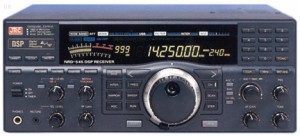Recently, my buddy Dave Zantow (N9EWO) told me that his Japan Radio Company JRC NRD-545 could natively decode Motorola C-Quam AM stereo (the “AMS” function). To be honest, I wasn’t aware that AM stereo had ever been an option on a tabletop receiver.
Of course, C-Quam (Compatible—Quadrature Amplitude Modulation) was intended to be used on the AM broadcast (medium wave) band. It was one of several techniques AM broadcasters championed in the mid to late 1980’s to transmit and receive AM stereo.
Incidentally, AM stereo never really caught on. Much like DRM (Digital Radio Mondiale), AM stereo was being transmitted by broadcasters, but there were very few stand alone receivers on the market that could decode the signal. To make matters worse, there were at least five different AM stereo formats being promoted simultaneously and they weren’t compatible. In the end, C-Quam was the most widely adopted.
Of course, C-Quam can be used on the shortwave bands as well, providing there’s enough signal to make a stereo lock. On December 1st, 2013, Dave recorded the shortwave radio pirate XFM who routinely broadcasts in C-Quam stereo. Note that XFM‘s signal was marginal, thus you’ll hear the stereo lock slip several times. Still, pretty amazing to hear:
When Dave sent his recording to XFM, he was told that it was the first stereo recording they had ever heard from a “stand alone” type receiver. Most listeners who listen in C-Quam do so with an SDR like the Perseus.
Here is a good example from YouTube:
If you would like to receive C-Quam AM stereo on your SDR, check out this informative discussion thread on HF Underground.
Many thanks, Dave for sharing your recording!
Readers: Dave’s website has numerous in-depth radio reviews. I encourage you to check them out!


I am process of developing some very new technology for C-QuAM, that can used both on receive and transmit. On the receiver side I publish information on Linkedin, about the my “new type of broadcast receiver”, that has AM stereo from 150 kHz up to 21 MHz, with adaptive audio processing.
On the transmitter side I using my new Class Q amplifier design, for high linearity and efficiency, that also has the adaptive audio encoding system. As I did not want your standard shortwave receiver design, as I was more interested in the sound quality as well as the receiver performance. To do this I needed design both ends (the transmitter and the receiver), to provide the best possible all round performance that can be possible with the C-QuAM format.
Therefore I would be interested to talking to those behind XFM shortwave, as I plan to develop my the transmitter technology in to a usable product, for AM broadcast stations, who are looking for the bast possible sound quality for their radio station. This taking me almost four years of research and development to get this system working and now time to get it on the air, to give new life to AM stereo and music stations on these bands.